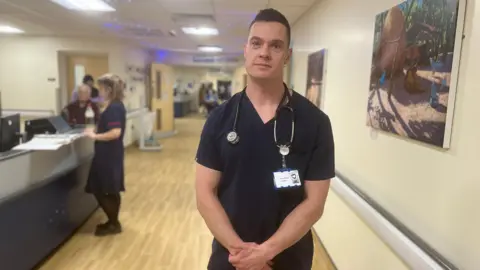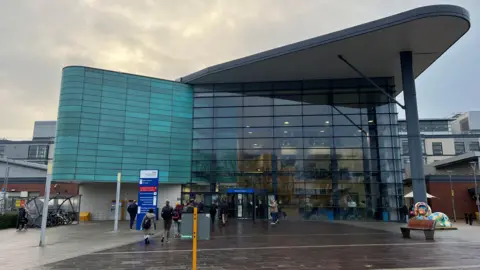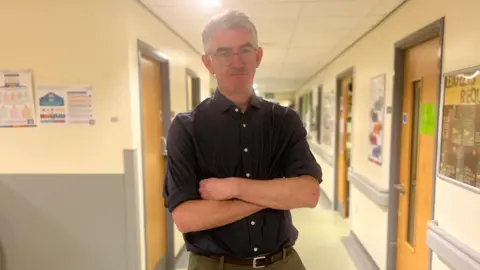New team launched to alleviate record A&E pressures
 BBC
BBCAt the front door of the Royal Derby Hospital's A&E department this winter, many patients have been surprised to be greeted with a medical face on arrival asking them why they're there.
Instead of going straight into the stretched A&E department - where University Hospitals of Derby and Burton (UHDB) NHS Trust bosses have acknowledged 12-hour waits have been on the increase because of surging demand - a new clinical team made up of nurses and paramedics carry out a quick assessment.
If possible, the patient will then be diverted away from A&E to an Urgent Treatment Centre (UTC) instead.
"It's about making sure people are seen at the right place at the right time to try and ease the congestion in A&E," said Scott Leach, an advanced clinical practitioner and part of the new "Interceptors" team introduced in December.
He said people were usually seen, treated and discharged within a few hours at a UTC, which was "freeing up A&E to see the poorly patients much quicker".
"We're probably intercepting anywhere from 40 and 70 patients a day," he added.
Many of the patients are those who would spend hours in A&E waiting to be seen, only to end up in a UTC later on anyway.
He said people had reacted positively to having someone trying to get them seen quicker, if not slightly "startled" at first to be asked about their needs so quickly.

UHDB's chief executive Stephen Posey recently apologised to patients for long waits and delays this winter, exacerbated by a so-called "quad-emic" of viruses made up of flu, Covid, norovirus and respiratory syncytial virus (RSV).
Patients waiting to be handed over to the Royal Derby Hospital from ambulances have also experienced record delays.
It is in response to these pressures that reactive measures have been put in place, in the hope the A&E department buckles less under the pressure.
Dr Tom Livingston is the clinical lead for a new emergency response team, which takes patients who require specialist care into another area of the hospital for quicker assessments and, if appropriate, treatment.
The team takes 500 patients a week, discharging 85% of those patients who are "seen and sorted".

The waiting time for patients to be seen who have come from A&E has also been cut from 11 to about four hours because of the team's efforts.
"I really dread to think what it would be like if we hadn't made those changes, because it would be really, really tough," said Dr Livingston.
"Not saying it's easy - it's not easy - but I think there's a lot of talk in the NHS about how places are struggling and I think we sometimes miss those really good improvements."
Dr Christopher Whale, from the trust, added: "Nobody likes waiting and we've had patients waiting longer than we'd want them to wait.
"That also creates a difficult environment for the staff because we all want to deliver the best quality care."
Follow BBC Derby on Facebook, on X, or on Instagram. Send your story ideas to [email protected] or via WhatsApp on 0808 100 2210.
